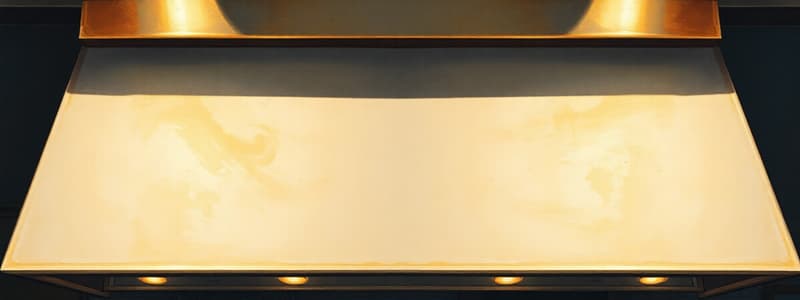Podcast
Questions and Answers
What is the minimum thickness of steel, in inches, required for the construction of commercial cooking hoods designed for collecting cooking vapors and residues?
What is the minimum thickness of steel, in inches, required for the construction of commercial cooking hoods designed for collecting cooking vapors and residues?
- 0.041
- 0.040
- 0.045
- 0.048 (correct)
Which of the following is the required method for seams, joints, penetrations, and duct-to-hood collar connections in exhaust duct systems?
Which of the following is the required method for seams, joints, penetrations, and duct-to-hood collar connections in exhaust duct systems?
- Liquid-tight continuous external welds (correct)
- Welded and riveted seams
- Solid heat welded seams
- Butt welding
How many feet above the appliance cooking surface should filters for exhaust duct systems be located?
How many feet above the appliance cooking surface should filters for exhaust duct systems be located?
- 4 (correct)
- 3 1/2
- 2
- 3
What is the minimum vertical separation, in feet, required for an exhaust outlet above any air intake located within 10 feet horizontally, when a 10-foot horizontal separation is not possible?
What is the minimum vertical separation, in feet, required for an exhaust outlet above any air intake located within 10 feet horizontally, when a 10-foot horizontal separation is not possible?
What is the minimum required air velocity, in feet per minute, through any duct in a commercial kitchen exhaust system?
What is the minimum required air velocity, in feet per minute, through any duct in a commercial kitchen exhaust system?
What clearance is required for hoods, grease removal devices, exhaust fans, and ducts to combustible material?
What clearance is required for hoods, grease removal devices, exhaust fans, and ducts to combustible material?
If the distance between a grease removal device and the appliance flue outlet is less than 18 inches, a steel baffle plate must be installed. What is the minimum distance, in inches, the baffle plate must be located from grease removal devices?
If the distance between a grease removal device and the appliance flue outlet is less than 18 inches, a steel baffle plate must be installed. What is the minimum distance, in inches, the baffle plate must be located from grease removal devices?
What is the maximum negative pressure, measured in inches of water column, that should be allowed in a commercial cooking area to prevent issues with exhaust fan systems?
What is the maximum negative pressure, measured in inches of water column, that should be allowed in a commercial cooking area to prevent issues with exhaust fan systems?
A duct system for removing cooking vapors is passing through six floors of a multi-story building. What is the minimum fire resistance rating, in hours, required for the enclosure housing the duct?
A duct system for removing cooking vapors is passing through six floors of a multi-story building. What is the minimum fire resistance rating, in hours, required for the enclosure housing the duct?
Rooftop terminations must be arranged to direct exhaust flow away from the roof surface. What is the minimum height, in inches, the exhaust outlet must be above the roof surface?
Rooftop terminations must be arranged to direct exhaust flow away from the roof surface. What is the minimum height, in inches, the exhaust outlet must be above the roof surface?
Flashcards
Hood thickness (steel)
Hood thickness (steel)
Commercial cooking hoods must be constructed of and supported by steel not less than 0.048 inches in thickness.
Exhaust duct connections
Exhaust duct connections
All seams, joints, penetrations, and duct-to-hood collar connections for exhaust duct systems shall have liquid-tight continuous external welds.
Filter Height
Filter Height
Filters for exhaust duct systems should be 4 feet above the appliance cooking surface.
Rooftop termination clearance
Rooftop termination clearance
Signup and view all the flashcards
Minimum duct air velocity
Minimum duct air velocity
Signup and view all the flashcards
Clearance to combustible material
Clearance to combustible material
Signup and view all the flashcards
Baffle plate distance
Baffle plate distance
Signup and view all the flashcards
Duct fire resistance
Duct fire resistance
Signup and view all the flashcards
Roof termination height
Roof termination height
Signup and view all the flashcards
Grease filter angle
Grease filter angle
Signup and view all the flashcards
Study Notes
- Commercial cooking hoods for collecting cooking vapors and residues must be constructed of and supported by steel not less than 0.048 inches in thickness.
- All seams, joints, penetrations, and duct-to-hood collar connections for exhaust duct systems require liquid-tight continuous external welds.
- Filters for exhaust duct systems must be 4 feet above the appliance cooking surface.
- Rooftop terminations need a minimum of 10 feet of clearance from the outlet to adjacent buildings, property lines, and air intakes.
- A vertical separation is allowed if space limitations prevent a 10-foot horizontal separation from an air intake: the exhaust outlet should be a minimum of 3 feet above any air intake within 10 feet horizontally.
- The air velocity through any duct shall be not less than 500 feet per minute.
Clearances for Hoods, Grease Removal, and Ducts
- Hoods, grease removal devices, exhaust fans, and ducts must maintain a clearance of at least 18 inches to combustible material, 3 inches to limited combustible material, and 0 inches to noncombustible, except where enclosures are needed.
- When the distance is less than 18 inches between a grease removal device and the appliance flue outlet, install a steel or stainless steel baffle plate located not less than 6 inches from the grease removal devices.
- The replacement air quantity in exhaust fan systems must be adequate to prevent negative pressures in commercial cooking areas from exceeding 0.02-inch water column.
- A duct system for removing cooking vapors (passing through six floors of a multi-story building) needs to be installed in an enclosure having a fire resistance rating of at least 2 hours.
- Roofing terminations should have exhaust flow directed up and away from the roof surface, and a minimum of 40 inches above the roof surface.
- A solid-fuel cooking device is not permitted within 3 feet of any deep fat frying unit.
- Grease filters must be installed at an angle not less than 45 degrees from the horizontal.
- Deep fat fryers in commercial establishments need a separate high-limit control to shut off fuel or energy when the fat temperature reaches 475 degrees Fahrenheit at 1 inch below the surface.
- The duct leaving the hood should be no less than 18 gage stainless steel.
- All deep-fat fryers need at least 16-inch space between the fryer and surface flames from adjacent cooking equipment.
- Replacement air quantity must be adequate to prevent negative pressures in the commercial cooking area(s) from exceeding 4.98 Pa.
- Deep-fat fryers should have separate high-limit controls to shut off fuel or energy when the temperature reaches 475°F at one inch below the surface.
- No solid fuel cooking device should be used for deep-fat frying involving more than 1 quart of liquid shortening.
- A range hood exhaust duct passing through six floors of a high-rise apartment building must be installed in an enclosure with a fire resistance rating of at least 2 hour(s).
- Hoods with dampers in the exhaust need an access panel to be located within 18 inches of the damper.
- A building 10 feet tall with a rooftop mount exhaust system should have a velocity pressure of 500.
- Wall terminations through a noncombustible wall should have a clearance of 10 feet from the outlet to adjacent buildings.
- All deep fat fryers should be installed with at least 16 inches of space between the fryer and surface flames.
- The closest point of any air intake above the plane of the exhaust termination should be a minimum of 10 feet.
- Replacement air should always be adequate to prevent negative pressures in commercial cooking from exceeding 4.98 Pa.
- Clearance from the duct to the interior surface of a limited combustible should not be less than 6 inches.
- The minimum clearance between a duct conveying grease and an outside air intake should be 10 feet.
Studying That Suits You
Use AI to generate personalized quizzes and flashcards to suit your learning preferences.



